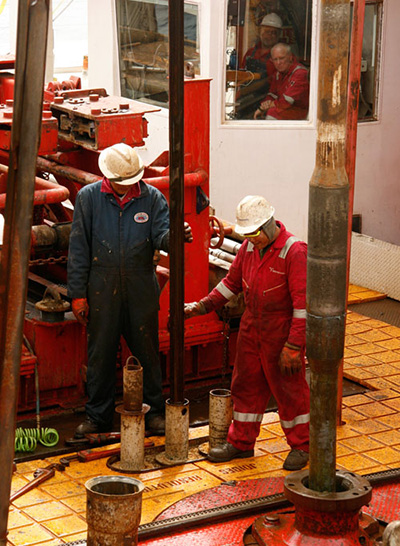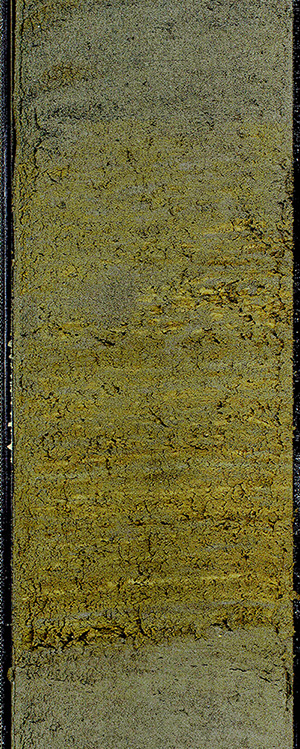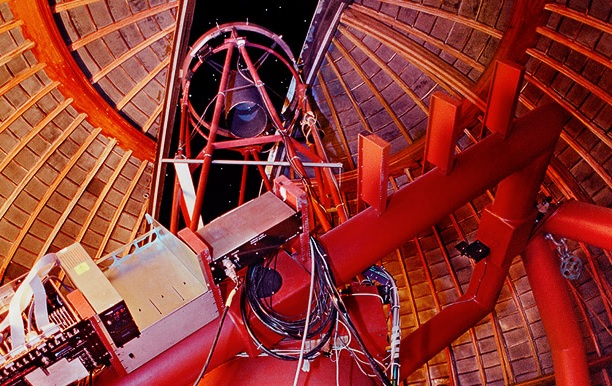From University of California-Santa Cruz (US)
June 02, 2021
Tim Stephens
stephens@ucsc.edu
An analysis of sediment cores from the Bering Sea has revealed a recurring relationship between warmer climates and abrupt episodes of low-oxygen “dead zones” in the subarctic North Pacific Ocean over the past 1.2 million years.
The new study, led by researchers at UC Santa Cruz, was published June 2 in Science Advances. The findings provide crucial information for understanding the causes of low oxygen or “hypoxia” in the North Pacific and for predicting the occurrence of hypoxic conditions in the future.

Crew members abroad the R/V JOIDES Resolution drilled sediment cores from the seafloor in the Bering Sea during a 2009 expedition on which UCSC ocean scientist Christina Ravelo was co-chief scientist. (Photo credit: Carlos Alvarez Zarikian, IODP/TAMU)

“It is essential to understand whether climate change is pushing the oceans toward a ‘tipping point’ for abrupt and severe hypoxia that would destroy ecosystems, food sources, and economies,” said first author Karla Knudson, who led the study as a graduate student in Earth sciences at UCSC.
The researchers based their findings on an analysis of deep sediment cores from a site in the Bering Sea. Over long periods of time, sediments are deposited and build up on the seafloor. The activity of organisms living in the seafloor sediments usually disrupts and mixes them as they accumulate, but if hypoxia has killed those organisms, an orderly pattern of layers is preserved. Thus, scientists can find a record of past hypoxic events in the form of these layered or “laminated” sediments in cores drilled from the seafloor.
Scientists have long known about a major episode of widespread hypoxia in the North Pacific at the end of the last ice age, when the melting of the ice sheets sent a massive influx of fresh water into the ocean. The new study provides the first records of earlier low-oxygen events, and shows that the most recent occurrence was not representative of most of these events in terms of mechanisms or timing.
“It doesn’t take a huge perturbation like melting ice sheets for this to happen,” said corresponding author Ana Christina Ravelo, professor of ocean sciences at UC Santa Cruz. “These abrupt hypoxic events are actually common in the geologic record, and they are not typically associated with deglaciation. They almost always happen during the warm interglacial periods, like the one we’re in now.”

The sediment cores hold a record of past low-oxygen events in the form of layered or “laminated” sediments. (Photo credit: IODP)
The hypoxia occurs after intense growth of phytoplankton (marine algae) in the surface waters. When the phytoplankton die, they sink deeper into the ocean and decompose, which depletes the oxygen and releases carbon dioxide into the water below the surface. What triggers these events, however, remains unclear. Ocean warming, high sea levels, and the availability of iron (a limiting factor for growth of phytoplankton) all seem to play a role.
“Our study shows that high sea levels, which occur during warm interglacial climates, contributed to these hypoxic events,” Knudson said. “During high sea levels, dissolved iron from the flooded continental shelves can be transferred to the open ocean and promote intense phytoplankton growth in the surface waters.”
Although high sea level is an important background condition, it is not enough to trigger a hypoxic event by itself. Changes in ocean circulation, including intensified upwelling to bring more nutrients into the surface waters and stronger currents that could transfer iron from the continental shelf to the open ocean, may play a critical role, Knudson said.
Currently regional dead zones occur in coastal areas around the world due to the temperature effects of climate warming as well as nutrient enrichment of coastal waters from agricultural fertilizers. But even the massive dead zone at the mouth of the Mississippi River pales in comparison to the widespread hypoxia that occurred all across the North Pacific Ocean at the end of the last ice age.
Because the new study is based on sediment cores from a single site, the researchers do not know the extent of the dead zones it records—whether they were confined to the Bering Sea or extended across the North Pacific rim as the most recent event did.
“We don’t know how extensive they were, but we do know they were very intense and lasted longer than the deglaciation event that has been so well studied,” said Ravelo, who was co-chief scientist of Integrated Ocean Drilling Program Expedition 323, which recovered the Bering Sea cores in 2009.
Knudson said the cores record multiple events during each interglacial period throughout the Pleistocene with abrupt transitions where laminated sediments appear and disappear in the core.
The new findings raise concerns about whether climate change and ocean warming will lead to a tipping point that would trigger widespread hypoxia in the North Pacific Ocean.
“The system is primed for this type of event happening,” Ravelo said. “We need to know how extensive they were, and we need to rethink how these events are triggered, because we now know that it doesn’t take a huge perturbation. This study sets the stage for a lot of follow-up work.”
In addition to Knudson and Ravelo, the coauthors of the paper include Ivano Aiello at Moss Landing Marine Laboratories, Christina Knudson at the University of St. Thomas in Minnesota (US), Michelle Drake at UC Santa Cruz, and Tatsuhiko Sakamoto at Mei University (JP) .
See the full article here .

five-ways-keep-your-child-safe-school-shootings
Please help promote STEM in your local schools.
![]()
Stem Education Coalition
 UC Santa Cruz (US) Lick Observatory Since 1888 Mt Hamilton, in San Jose, California, Altitude 1,283 m (4,209 ft)
UC Santa Cruz (US) Lick Observatory Since 1888 Mt Hamilton, in San Jose, California, Altitude 1,283 m (4,209 ft)
 UC Observatories Lick Automated Planet Finder fully robotic 2.4-meter optical telescope at Lick Observatory, situated on the summit of Mount Hamilton, east of San Jose, California, USA.
UC Observatories Lick Automated Planet Finder fully robotic 2.4-meter optical telescope at Lick Observatory, situated on the summit of Mount Hamilton, east of San Jose, California, USA.
 The UCO Lick C. Donald Shane telescope is a 120-inch (3.0-meter) reflecting telescope located at the Lick Observatory, Mt Hamilton, in San Jose, California, Altitude 1,283 m (4,209 ft).
The UCO Lick C. Donald Shane telescope is a 120-inch (3.0-meter) reflecting telescope located at the Lick Observatory, Mt Hamilton, in San Jose, California, Altitude 1,283 m (4,209 ft).
 UC Santa Cruz (US) campus.
UC Santa Cruz (US) campus.
The University of California-Santa Cruz (US) , opened in 1965 and grew, one college at a time, to its current (2008-09) enrollment of more than 16,000 students. Undergraduates pursue more than 60 majors supervised by divisional deans of humanities, physical & biological sciences, social sciences, and arts. Graduate students work toward graduate certificates, master’s degrees, or doctoral degrees in more than 30 academic fields under the supervision of the divisional and graduate deans. The dean of the Jack Baskin School of Engineering oversees the campus’s undergraduate and graduate engineering programs.
UCSC is the home base for the Lick Observatory.
 UCO Lick Observatory’s 36-inch Great Refractor telescope housed in the South (large) Dome of main building.
UCO Lick Observatory’s 36-inch Great Refractor telescope housed in the South (large) Dome of main building.
Search for extraterrestrial intelligence expands at Lick Observatory
New instrument scans the sky for pulses of infrared light
March 23, 2015
By Hilary Lebow

Astronomers are expanding the search for extraterrestrial intelligence into a new realm with detectors tuned to infrared light at UC’s Lick Observatory. A new instrument, called NIROSETI will soon scour the sky for messages from other worlds.

“Infrared light would be an excellent means of interstellar communication,” said Shelley Wright, an assistant professor of physics at UC San Diego (US) who led the development of the new instrument while at the U Toronto Dunlap Institute for Astronomy and Astrophysics (CA).

Wright worked on an earlier SETI project at Lick Observatory as a UC Santa Cruz undergraduate, when she built an optical instrument designed by UC Berkeley researchers. The infrared project takes advantage of new technology not available for that first optical search.
Infrared light would be a good way for extraterrestrials to get our attention here on Earth, since pulses from a powerful infrared laser could outshine a star, if only for a billionth of a second. Interstellar gas and dust is almost transparent to near infrared, so these signals can be seen from great distances. It also takes less energy to send information using infrared signals than with visible light.
Frank Drake, professor emeritus of astronomy and astrophysics at UC Santa Cruz and director emeritus of the SETI Institute, said there are several additional advantages to a search in the infrared realm.


“The signals are so strong that we only need a small telescope to receive them. Smaller telescopes can offer more observational time, and that is good because we need to search many stars for a chance of success,” said Drake.
The only downside is that extraterrestrials would need to be transmitting their signals in our direction, Drake said, though he sees this as a positive side to that limitation. “If we get a signal from someone who’s aiming for us, it could mean there’s altruism in the universe. I like that idea. If they want to be friendly, that’s who we will find.”
Scientists have searched the skies for radio signals for more than 50 years and expanded their search into the optical realm more than a decade ago. The idea of searching in the infrared is not a new one, but instruments capable of capturing pulses of infrared light only recently became available.
“We had to wait,” Wright said. “I spent eight years waiting and watching as new technology emerged.”
Now that technology has caught up, the search will extend to stars thousands of light years away, rather than just hundreds. NIROSETI, or Near-Infrared Optical Search for Extraterrestrial Intelligence, could also uncover new information about the physical universe.
“This is the first time Earthlings have looked at the universe at infrared wavelengths with nanosecond time scales,” said Dan Werthimer, UC Berkeley SETI Project Director. “The instrument could discover new astrophysical phenomena, or perhaps answer the question of whether we are alone.”
NIROSETI will also gather more information than previous optical detectors by recording levels of light over time so that patterns can be analyzed for potential signs of other civilizations.
“Searching for intelligent life in the universe is both thrilling and somewhat unorthodox,” said Claire Max, director of UC Observatories and professor of astronomy and astrophysics at UC Santa Cruz. “Lick Observatory has already been the site of several previous SETI searches, so this is a very exciting addition to the current research taking place.”
NIROSETI will be fully operational by early summer and will scan the skies several times a week on the Nickel 1-meter telescope at Lick Observatory, located on Mt. Hamilton east of San Jose.
The NIROSETI team also includes Geoffrey Marcy and Andrew Siemion from UC Berkeley; Patrick Dorval, a Dunlap undergraduate, and Elliot Meyer, a Dunlap graduate student; and Richard Treffers of Starman Systems. Funding for the project comes from the generous support of Bill and Susan Bloomfield.
